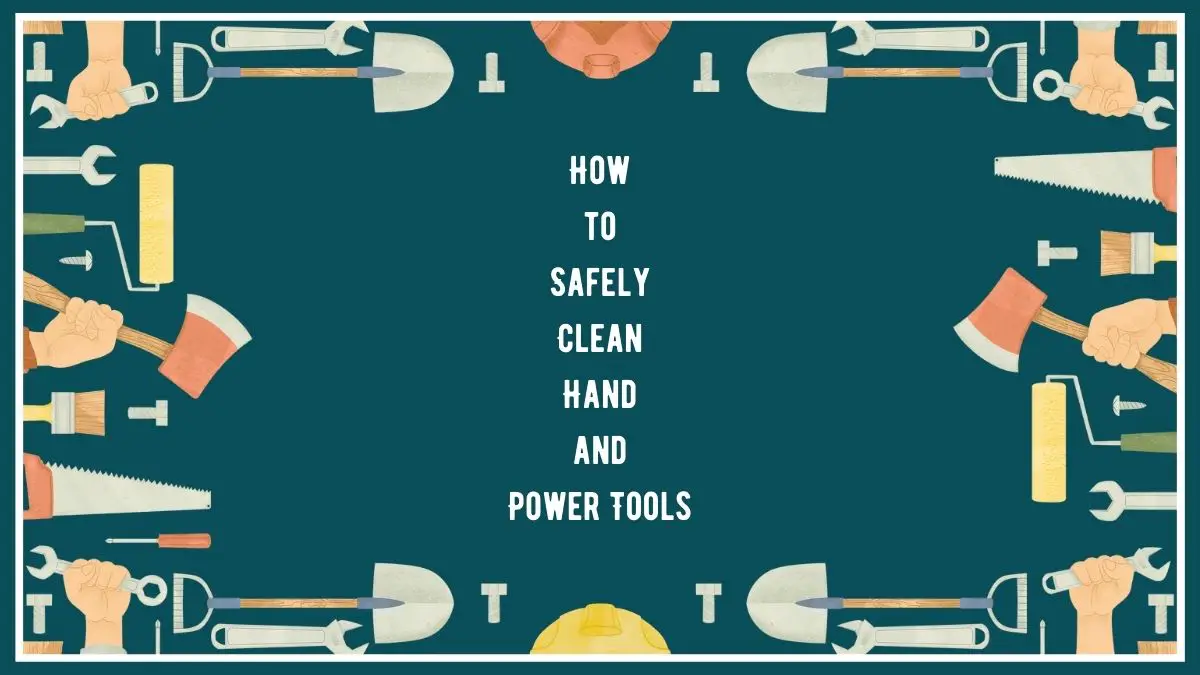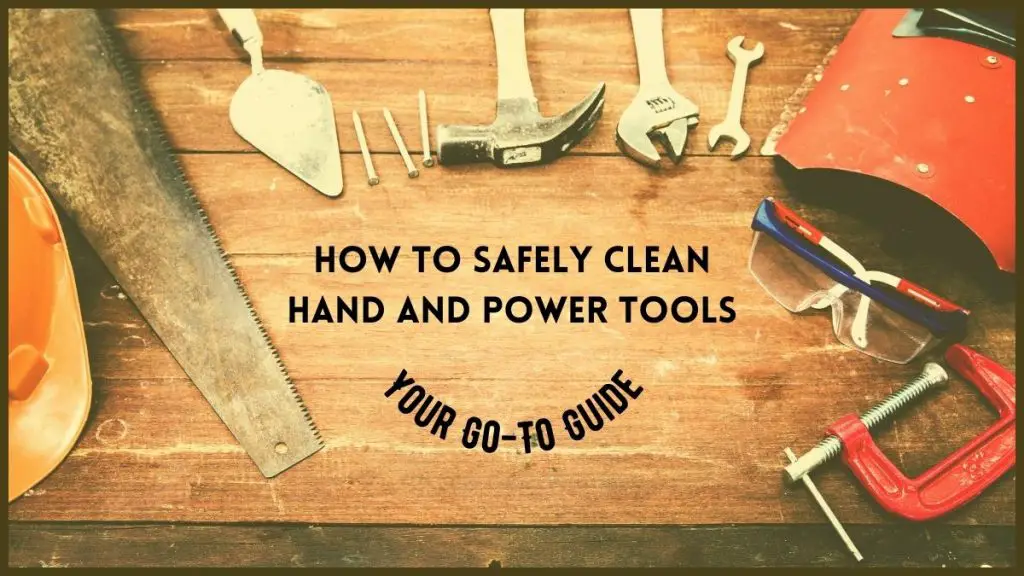
To clean hands and power tools, use a mild detergent and warm water. Ensure thorough drying to prevent rust and corrosion. Basically, we will discuss how to clean hand and power tools safely, which would be an effective guide for tool users.
Proper cleaning and maintenance of tools can help prolong their lifespan and maintain their performance. Clean tools also prevent the transfer of dirt and debris to materials being worked on, ensuring quality results. Neglecting to clean hand and power tools can lead to damage, tarnishing, and reduced effectiveness.
Regular cleaning and maintenance are essential practices for any professional or hobbyist working with tools. Implementing proper cleaning techniques can save time and money in the long run by preventing the need for costly repairs or replacements. Regular cleaning also promotes a safe working environment, reducing the risk of accidents and injuries.
Related Article: Tools Every Man Needs: Power Up Your Toolkit!

Related Article: Power Tools for Women: DIY Projects Made Easy
You may also read: Mechanic Work Shirts: The Ultimate Apparel for Automotive Enthusiasts
Importance Of Cleaning Hand And Power Tools
Cleaning hand and power tools is crucial for their longevity and performance. Proper maintenance can prevent rust and corrosion, as well as ensure that the tools function properly. By understanding the importance of cleaning these tools, you can extend their lifespan and maintain their effectiveness.
Preventing Rust And Corrosion
Hand and power tools are often exposed to moisture, dirt, and other elements that can cause rust and corrosion. Regular cleaning and proper storage can help prevent these damaging effects. When tools are clean and dry, they are less likely to succumb to rust, ensuring that they remain in good working condition.
Maintaining Proper Functionality
Dirty and improperly maintained hand and power tools can lead to malfunctions and breakdowns. Cleaning these tools removes debris and contaminants that can impede their functionality, ensuring they perform at their best when needed. Regular maintenance helps preserve the precision and reliability of the tools, ultimately contributing to safer and more efficient work.
Related Article: The 9 Best Tool Bags 2024 for Professional Users

Credit: www.housebeautiful.com
Related Article: The Top 9 Best Mechanic Tool Brands for Professional Users
Supplies Needed For Cleaning Tools
To effectively clean hand and power tools, you will need a few essential supplies such as a brush, mild soap, clean cloth, and lubricant. Regular maintenance and cleaning of your tools will ensure their longevity and optimal performance.
Supplies Needed for Cleaning Tools Properly maintaining your hand and power tools is crucial for their performance and longevity. To effectively clean your tools, you’ll need the following supplies. Cleaning Solutions Wooden Tool Handles Scrubbing Brush Mineral Spirits Rust Remover White Vinegar Metal Tool Surfaces Steel Wool Rust-Inhibiting Spray Rubbing Alcohol Lubricating Oil Brushes and Cloths Wire Brush Shop Towels Microfiber Cloth Protective Gear Vinyl or Nitrile Gloves Safety Glasses Properly cleaning your hand and power tools extends their lifespan and ensures their efficient performance. Regular maintenance is vital to avoid rust and corrosion, which can compromise the functionality and safety of your tools. Now, let’s dive into the supplies needed for cleaning your valuable tools.
Steps To Clean Hand And Power Tools
Regular cleaning of hand and power tools is vital to maintain their efficiency and ensure their longevity. By properly cleaning and maintaining these tools, you can extend their lifespan and prevent any potential damage. In this blog post, we will discuss the step-by-step process of cleaning hand and power tools. Following these steps will not only help you keep your tools in top condition but also ensure your safety during the cleaning process.
Safety Precautions
Prior to cleaning, it is crucial to take appropriate safety precautions to protect yourself from any potential harm. Here are some safety measures to keep in mind:
- Wear protective gloves and goggles to shield your hands and eyes from any debris or chemicals.
- Work in a well-ventilated area to avoid inhaling any fumes or dust particles.
- Make sure to disconnect any power supply to avoid accidental starts or electrical shock.
- Inspect the tools for any damage or wear and tear before cleaning to prevent any accidents during the cleaning process.
Disassembly And Inspection
Before cleaning, it is important to disassemble the tools, if possible, to reach all the nooks and crannies. This will ensure effective cleaning and thorough removal of dirt and grime. Here’s how you can disassemble and inspect your tools:
- Refer to the manufacturer’s instructions to disassemble the tools properly.
- Carefully examine each part for any signs of damage, rust, or wear.
- Inspect the power cords or cables for any fraying or exposed wires.
- Check the handles and grips for any cracks or deterioration.
Removing Stubborn Dirt And Grease
Hand and power tools often accumulate stubborn dirt, grease, and residue over time. To remove these tough contaminants, follow these steps:
- Use a stiff-bristle brush or toothbrush to scrub off any loose dirt or grime.
- If necessary, apply a degreaser or solvent to dissolve and loosen stubborn grease.
- Scrub the surfaces thoroughly, paying attention to hard-to-reach areas.
- Rinse the tools with clean water to remove any residue or cleaning agents.
Cleaning With Solution
Cleaning solutions can effectively disinfect and remove any remaining dirt, grease, or contaminants. Follow these steps for proper cleaning:
- Prepare a mild solution of warm water and dish soap or a specialized tool cleaner.
- Dip a clean cloth or sponge into the cleaning solution.
- Gently wipe down all the parts of the tools, ensuring thorough coverage.
- For stubborn stains or grime, you may need to use a soft-bristle brush or toothbrush.
- Rinse the tools with clean water and wipe them dry with a cloth.
Drying And Reassembling
After cleaning, it is important to thoroughly dry the tools to prevent rust or corrosion. Here’s how you can dry and reassemble your freshly cleaned tools:
- Wipe each part of the tools with a dry cloth to remove any moisture.
- Leave the disassembled tools in a well-ventilated area to air dry completely.
- Once dry, reassemble the tools carefully, ensuring each part is securely fastened.
- Inspect the power cords or cables for any damage or wear and replace if necessary.
Related Article: Best Power Tool Brands of 2024 for Professional Users

Credit: www.grainger.com
Related Article: The 9 Best Hand Tool Brands of 2024 for Professional Users
Special Techniques For Different Tools
To maintain your hand and power tools, it’s essential to use the right cleaning tools and techniques. For hand tools, a wire brush can help remove rust and debris, while power tools often benefit from an air compressor to blow away dust and dirt.
Regular maintenance ensures the longevity of your tools.
Cleaning hand and power tools is essential to maintain their functionality and prolong their lifespan. However, different tools require different cleaning techniques to ensure optimal results. In this section, we will explore the special techniques for cleaning hand tools and power tools.
Cleaning Hand Tools
Hand tools are commonly used in various tasks, from carpentry to gardening. Proper cleaning of hand tools not only removes dirt and grime but also helps prevent rust and corrosion. Here are some special techniques to effectively clean your hand tools:
1. Wipe with a Damp Cloth:
The first step in cleaning hand tools is to wipe them with a damp cloth. This removes surface dirt and residue, making it easier to identify any areas that require further attention.
2. Use a Wire Brush:
If your hand tools have stubborn dirt or rust, a wire brush can come in handy. Gently scrub the affected areas to remove debris and rust buildup. Be sure to use a wire brush appropriate for the material of your tools.
3. Apply a Rust Remover:
For severely rusted hand tools, applying a rust remover can help restore their condition. Follow the instructions provided by the rust remover product and use it cautiously to avoid damaging the tool’s surface.
4. Lubricate with Oil:
Once the hand tools are clean and free from rust, it’s essential to lubricate them to prevent future corrosion. Apply a light coating of oil to the tools, ensuring all the moving parts are well-greased.
Cleaning Power Tools
Power tools are a valuable asset for any DIY enthusiast or professional tradesperson. To keep them functioning at their best, regular cleaning is necessary. Here are some special techniques to clean power tools effectively:
1. Unplug and Disassemble:
Before cleaning power tools, always ensure they are unplugged from the power source. Disassemble any detachable parts, such as blades or bits, as this makes cleaning more accessible.
2. Blow Away Dust and Debris:
Using compressed air or a blower, carefully blow away any dust and debris from the power tool’s surfaces, vents, and crevices. Pay extra attention to areas where particles tend to accumulate, such as cooling fans.
3. Brush Away Residue:
With a soft brush or toothbrush, gently brush away any remaining residue from the power tool. Be thorough but cautious not to damage any delicate components.
4. Clean with a Damp Cloth:
Wipe down the power tool with a damp cloth to remove any grime or stubborn stains. Ensure the tool is completely dry before reassembling and storing it.
5. Lubricate Moving Parts:
Just like hand tools, power tools with moving parts require proper lubrication. Apply an appropriate lubricant to the gears, bearings, and other moving components as recommended by the manufacturer. Remember, cleaning your tools regularly is not only beneficial for their performance but also for your safety. By following these special techniques, you can ensure that your hand tools and power tools are always in excellent condition for your next project.
Related Article: Top 9 Best DIY Tools To Complete A DIY Project

Credit: www.amazon.com
Related Article: The Essential DIY Tips Need to Complete Your Home Renovation
Storing And Maintaining Tools After Cleaning
Once you have successfully cleaned your hand and power tools, it’s important to store and maintain them properly. Proper storage and regular maintenance not only prolong the lifespan of your tools but also ensure their optimal performance whenever you need to use them.
Proper Storage
Basically, proper storage is crucial to keep your tools in good condition, particularly when they are not in use. Here are a few tips on storing tools:
- Keep tools in a dry and climate-controlled environment to prevent rust and corrosion.
- Store tools in a well-organized manner, either hanging them on a pegboard or placing them in a labeled tool chest or toolbox.
- Use proper tool holders or racks to prevent any damage or accidents.
- Avoid storing tools in areas with high humidity or extreme temperature fluctuations.
- Consider using silica gel packets or a dehumidifier in your storage area to control moisture.
Regular Maintenance
In addition to proper storage, regular maintenance is essential to ensure your tools remain in their best working condition. Here are some maintenance practices to follow:
- Keep your tools clean and free from dirt, grease, or any buildup that can hinder their performance.
- Regularly inspect your tools for any signs of wear and tear, cracks, or loose parts.
- Check and tighten any loose screws, bolts, or handles to prevent accidents during use.
- Apply lubricants or protective coatings to prevent rust and ensure smooth operation of moving parts.
- Sharpen blades or replace worn-out bits to maintain cutting effectiveness.
By incorporating these maintenance practices into your routine, you can ensure that your hand and power tools are ready for any task at hand. Remember, a well-maintained tool is a dependable tool.
Related Article: Best Hand Tools For Beginners To Complete Tasks Easily

Related Article: The 11 Basic Hand Tools Safety Rules for Professional Users
Frequently Asked Questions Of What Should You Use To Clean Hand And Power Tools
What Tool Should You Use To Clean Hand And Power Tools?
Use a cleaning solvent to wipe dirt and grime from hands and power tools. Ensure a thorough drying process for rust prevention.
What Is The Best Thing To Clean Power Tools With?
The best way to clean power tools is by using a degreaser or a mild soap and water solution. Make sure to disconnect the tool from any power source before cleaning. Wipe off any excess dirt or debris, then use a cloth or brush to clean the tool thoroughly.
What Is The Best Way To Clean Hand Tools?
The best way to clean hand tools is by using a mixture of warm water and mild soap. Gently scrub the tools with a soft brush or cloth, removing any dirt or grime. Rinse thoroughly with clean water and dry completely before storing them.
What Should You Use To Clean Hand And Power Tools A Soft Cloth Oil Brush Abrasive Pad Magic Eraser?
To clean hands and power tools, you can use a soft cloth, oil brush, abrasive pad, or a magic eraser. These tools effectively remove dirt and grime, ensuring that your tools remain clean and in good working condition.
To know more about How to clean and maintain hand tools>>
Related Article: Best Automotive Tools: Essential Gear for Every Car Enthusiast
Conclusion
To maintain the longevity and effectiveness of your hand and power tools, proper cleaning is essential. Regularly removing dirt, debris, and rust can greatly extend their lifespan and enhance their performance. Remember to use the appropriate cleaning materials and techniques for each type of tool to prevent damage.
By dedicating a little time to cleaning your tools, you can ensure they remain in optimal condition for all your future projects.
Related Article: The 11 Basic Power Tools Safety Rules for Professional Users





4 thoughts on “How to Clean Hand and Power Tools Safely: Your Go-To Guide”